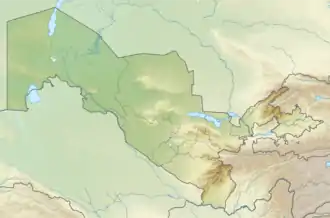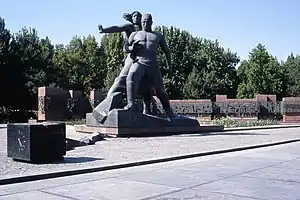 | |
| UTC time | 1966-04-25 23:22:49 |
|---|---|
| ISC event | 848721 |
| USGS-ANSS | ComCat |
| Local date | 26 April 1966 |
| Local time | 05:22:49 |
| Magnitude | 5.2 Mw [1] |
| Epicenter | 41°10′N 69°08′E / 41.16°N 69.13°E |
| Areas affected | Soviet Union Uzbek SSR |
| Max. intensity | VII (Very strong)[2] |
| Casualties | 15–200 killed |
The 1966 Tashkent earthquake (Uzbek: Toshkent zilzilasi; Russian: Ташкентское землетрясение) occurred on 26 April in the Uzbek SSR. It had a moment magnitude of 5.2 with an epicenter in central Tashkent at a depth of 3–8 kilometers (1.9–5.0 mi). The earthquake caused massive destruction to Tashkent, destroying most of the buildings in the city, killing between 15 and 200 people and leaving between 200,000 and 300,000 homeless. Following the disaster, most of the historic parts of Tashkent had been destroyed and the city was rebuilt, based on Soviet architectural styles.[3][4] Soviet authorities created an institute of seismology in order to forecast future earthquakes.
Background
Tashkent and its immediate vicinity were prone to earthquakes and 74 earthquakes of a magnitude between 3 and 6 had been recorded from 1914 to 1966.[5] The city had been damaged by earthquakes in 1866 and 1886.[6]
Concerns about possible earthquake damage to the city were raised in the 1940s and 1950s, especially after Ashgabat was devastated in an earthquake in 1948.[7] Before the Tashkent earthquake, an increase in radon levels had been noticed.[8]
Earthquake
The earthquake occurred at 05:23[9][10] at the very shallow (and more destructive) depth of 3–8 kilometers (1.9–5.0 mi)[10] with its epicentre in the centre of the city.[11]
The quake caused massive destruction to property. In total, over 80% of the city was destroyed,[12] including over half of the old city.[13]
In total, between 78,000[14] and 95,000 homes were destroyed.[15] Most of these were traditional adobe housing in more densely populated central areas.[16] The majority of the most significant buildings in Tashkent were destroyed; this included 600-year-old mosques.[17] Most of these buildings predated the Russian Revolution of 1917.[18] However, only Navoi Theater, which was built by Japanese prisoners of war was unharmed.[19][20][21]
Estimates of those made homeless by the disaster ranged from 200,000[15][22] to 300,000.[23]
While the official death toll was 15 people[23] this figure may be an underestimate due to Soviet secrecy[24][25] and other sources estimated death tolls ranging from 200 people[17] to 0.5%[26] of the city's population of 1,100,000.[27] Over 20% more women than men were killed.[26]
Aftermath

In the immediate aftermath of the disaster, senior Soviet figures, including CPSU Chairman Leonid Brezhnev, flew to Tashkent to supervise the recovery efforts.[10] A massive rebuilding project was started,[17] with other Soviet republics sending large numbers of workers to assist in the rebuilding process.[27][28] This changed the ethnic make up of the city, as many of them remained in Tashkent after the work had been completed.[28] The new Tashkent contained architectural styles found in other Soviet cities[14] such as wide boulevards[28] and large apartment block complexes.[14] By 1970, 100,000 new homes had been constructed.[14]
The earthquake also resulted in increased religiosity, with increased interest in many Islamic ritual practices.[29]
To prevent further such disasters from having such a serious impact on the city, in 1966 Soviet authorities created an Institute of seismology, tasked with monitoring seismic changes, such as changes in radon levels and predicting earthquakes.[30]
A memorial stone to victims of the earthquake located above the epicentre was unveiled in 1976.[9]
See also
References
- ↑ ISC (27 June 2022), ISC-GEM Global Instrumental Earthquake Catalogue (1900–2009), Version 9.1, International Seismological Centre
- ↑ Bindi, D.; Abdrakhmatov, K.; Parolai, S.; Mucciarelli, M.; Grünthald, G.; Ischukf, A.; Mikhailova, N.; Zschau, J. (2012), "Seismic hazard assessment in Central Asia: Outcomes from a site approach", Soil Dynamics and Earthquake Engineering, 37: 7, Bibcode:2012SDEE...37...84B, doi:10.1016/j.soildyn.2012.01.016
- ↑ Cowan, Janice (2006). A Spy's Wife: The Moscow Memoirs of a Canadian who Witnessed the End of the Cold War. James Lorimer & Company. p. 74. ISBN 978-1-55028-931-2.
- ↑ Schwartz, Stephen (2008). The Other Islam: Sufism and the Road to Global Harmony. Crown Publishing Group. p. 222. ISBN 978-0-385-52665-4.
- ↑ Bubis, I.I. (September 1966). "Engineering analysis of the aftereffects of the Tashkent earthquake, April 26, 1966". Soil Mechanics and Foundation Engineering. 3 (5): 339–344. Bibcode:1966SMFE....3..339B. doi:10.1007/BF01706148. S2CID 112220850.
- ↑ Adle, Chahryar (2005). History of Civilizations of Central Asia: Towards the contemporary period : from the mid-nineteenth to the end of the twentieth century. UNESCO. p. 830. ISBN 9789231039850.
- ↑ Stronski, Paul (2010). Tashkent: Forging a Soviet City, 1930–1966. University of Pittsburgh Press. pp. 159–160. ISBN 978-0-8229-7389-8.
- ↑ Cothern, C.Richard (1987). Environmental Radon. Vol. 35. ISBN 978-0-306-42707-7.
{{cite book}}:|journal=ignored (help) - 1 2 Lovell-Hoare, Sophie (2013). Uzbekistan. Bradt Travel Guides. p. 100. ISBN 978-1-84162-461-7.
- 1 2 3 Agrawal, Premendra (2012). Silent Assassins Jan11,1966. Agrawal Overseas. p. 291. ISBN 9789350878453.
- ↑ Shoumatoff, Nicholas (2000). Around the Roof of the World. University of Michigan Press. p. 186. ISBN 978-0-472-08669-6.
- ↑ Christensen, Anna (22 January 1984). "New Old collide in Tashkent". Deseret News. Retrieved 3 December 2014.
- ↑ United Nations. Economic and Social Commission for Asia and the Pacific (2003). The Ground Beneath Our Feet: A Factor in Urban Planning, Volume 14 of Atlas of urban geology. United Nations Publications. p. 110. ISBN 9789211201543.
- 1 2 3 4 Sadikov, A C; Akramob, Z. M.; Bazarbaev, A.; Mirzlaev, T.M.; Adilov, S. R.; Baimukhamedov, X. N.; et al. (1984). Geographical Atlas of Tashkent (Ташкент Географический Атлас) (in Russian). Moscow. pp. 60, 64.
{{cite book}}: CS1 maint: location missing publisher (link) - 1 2 Ruthven, Malise (2004). Historical Atlas of Islam. Harvard University Press. p. 145. ISBN 978-0-674-01385-8.
- ↑ Nurtaev Bakhtiar (199). "Damage for buildings of different type". Institute of Geology and Geophysics, Academy of Sciences of Uzbekistan. Retrieved 4 December 2014.
- 1 2 3 Rall, Ted (2006). Silk Road to Ruin: Is Central Asia the New Middle East?. NBM. p. 141. ISBN 978-1-56163-454-5.
- ↑ "title unknown". Science Journal. 4: 74. 1968.
- ↑ Katsumi Akai『Okayama zatsugaku nōto』Kibitoshuppan 2000 p.118-121
- ↑ "Award Ceremony and Celebration for the Monodzukuri Nippon (Japan's Manufacturing) Grand Award". Prime Minister of Japan and His Cabinet. Retrieved 2019-06-06.
- ↑ "Japan-Uzbekistan Relations". Ministry of Foreign Affairs (Japan). Retrieved 2019-06-06.
- ↑ Bunich, Igor (2004). НЛО: Операция "Троянский конь" Секретные материалы. Olma Media Group. p. 182. ISBN 9789211201543.
- 1 2 Schmemann, Serge (21 March 1984). "Big tremor rocks Central Asia area". The New York Times. Retrieved 3 December 2014.
- ↑ Hutchings, Ramond (1988). Soviet Secrecy and Non-secrecy. Rowman & Littlefield. p. 70. ISBN 978-0-389-20754-2.
- ↑ Huxley, Michael (1973). "title unknown". The Geographical Magazine. 46: 411.
- 1 2 Stoltman, Joseph (2007). International Perspectives on Natural Disasters: Occurrence, Mitigation, and Consequences: Occurrence, Mitigation, and Consequences, Volume 21 of Advances in natural and technological hazards research. Springer Science & Business Media. p. 435. ISBN 978-1-4020-2851-9.
- 1 2 Roscoe Wright, James (1971). Industrialized Building in the Soviet Union: (a Report of the U.S. Delegation to the U.S.S.R.). U.S. Government Printing Office. p. 15. ISBN 9789211201543.
- 1 2 3 Hanks, Reuel (2005). Central Asia: A Global Studies Handbook. ABC-CLIO. p. 32. ISBN 978-1-85109-656-5.
- ↑ Ramet, Sabina (1989). Religion and Nationalism in Soviet and East European Politics. Duke University Press. p. 205. ISBN 978-0-8223-0891-1.
- ↑ Lee, William (2003). International Handbook of Earthquake & Engineering Seismology, Part 2, Volume 81, Part 2 of International Geophysics. Academic Press. p. 1465. ISBN 978-0-08-048923-0.
Further reading
- Raab, Nigel (2014), "The Tashkent Earthquake of 1966: The Advantages and Disadvantages of a Natural Tragedy", Jahrbücher für Geschichte Osteuropas, 62 (2): 273–294, doi:10.25162/jgo-2014-0012, JSTOR 43819634, S2CID 252454991